 W
WThe flag of Spain, as it is defined in the Constitution of 1978, consists of three horizontal stripes: red, yellow and red, the yellow stripe being twice the size of each red stripe. Traditionally, the middle stripe was defined by the more archaic term of gualda, and hence the popular name la Rojigualda (red-weld).
 W
WThe current flag of Andalusia was adopted in 1918. Blas Infante (1885–1936), the "Father of the Andalusian Fatherland", initiated an assembly at Ronda in 1918. This assembly adopted a charter based on the Antequera Constitution and also adopted the current flag of Andalusia and emblem as "national symbols". Its name used to be Arbonaida or also Arbondaira.
 W
WThe arrano beltza is an ancient Basque and Navarre symbol depicting a black heraldic eagle upon a yellow background. Today, it is mostly used by Basque nationalists as a symbol of sovereignty and independence.
 W
WThe flag of Asturias shows the "Cruz de la Victoria" in yellow over blue.
 W
WThe flag of the Balearic Islands is the official flag of the Balearic Islands, an autonomous community of Spain located in the western Mediterranean Sea. The flag, which was adopted in the 1983 Statute of Autonomy, incorporates the design of the Senyera.
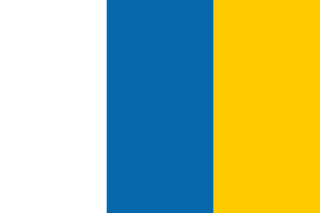 W
WThe flag of the Autonomous Community of the Canary Islands is a vertical tricolour of three equal bands of white, blue, and yellow. The state flag includes the Coat of arms of the Canary Islands in the central band; the civil flag omits this. The designs were made official by the Statute of Autonomy of the Canarian Autonomous Community on 16 August 1982.
 W
WThe colours of the official flag of Cantabria (Spain), which is the symbol of the region, are established in the very text of the Autonomy Statute. Only the characteristics of the coat of arms that was to feature in the regional flag were left to specify, which was carried out by a Law of the Regional Assembly, approved on 22 December 1984. From that moment on, the flag of Cantabria is made up of two horizontal stripes of equal width, white on the top and red on the bottom, and the regional coat of arms in its centre. The flag design is heir to the ship registration flag of the maritime province of Santander, assigned by Royal Order of 30 July 1845.
 W
WThe flag of Castile and León is the official flag of the Spanish autonomous community of Castile and León. It consists of the quartered coats of arms of Castile, represented by a castle, and León, represented by a lion.
 W
WThe Cross of Burgundy or the Cross of Saint Andrew, a saw-toothed form of St. Andrew's cross, was first used in the 15th century as an emblem by the Valois Dukes of Burgundy, who ruled a large part of eastern France and the Low Countries as effectively an independent state. The Burgundian Low Countries were inherited by the Habsburgs, who adopted the flag at the extinction of the Valois ducal line and continued to use it as one of their many symbols up to the 18th century. With the Burgundian Habsburgs coming to power in Spain in the 16th century, the emblem served as a naval ensign of the Spanish Empire up to 1701, and up to 1843 as the land battle flag, acquiring a global impact throughout Europe and the Americas in the possessions of the Spanish crowns of Castile and Aragon. It is found nowadays in different continents and still appears on regimental colours, badges, shoulder patches and company guidons. The use of the emblem in a variety of contexts, in a number of European countries and in the Americas, reflects the historical extent of Burgundian, Habsburg, and Spanish territories.
 W
WThe estreleira is the flag used by Galician nationalists of left-of-centre to far-left ideological allegiance.
 W
WThe flag of Extremadura, according to Article 4-1 of the Statute of Autonomy, consists of three horizontal stripes of green, white, and black. The state flag, used by Extremadura's government and administration, must use the variant with the coat of arms of the region off-centred toward the hoist.
 W
WThe flag of Castilla–La Mancha is one of the representative symbols of the Autonomous Community of Castilla–La Mancha, in Spain, defined by its Statute of Autonomy.
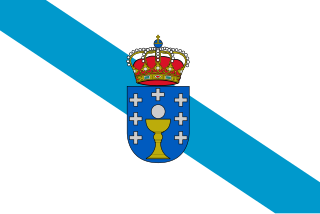 W
WThe flag of Galicia appeared for first time in the 19th century, probably based on the colours of the ancient medieval flags of the Kingdom of Galicia. Originally, the flag was probably a blue St Andrew's Cross over a white field – St Andrew is one of the most popular saints in Galicia. The Coat of Arms of Galicia was actually the former flag of the Kingdom of Galicia. The colors blue, white and gold were always related with Galicia. The chalice, with a silver host, and the golden crosses on blue background have been its symbol since medieval times. For some time it was thought that it was based on the flag of the maritime province of Corunna, but today it is known that the design is earlier.
 W
WThe ikurrina flag or ikurriña is a Basque symbol and the official flag of the Basque Country Autonomous Community of Spain. This flag consists of a white cross over a green saltire on a red field.
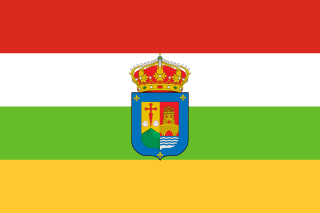 W
WThe flag of La Rioja is one of the symbols of the autonomous community of La Rioja. It was sanctioned for use by the former governing body of the provincial council for what was then known as the Province of Logroño in 1979 and it appears in the Statute of Autonomy of La Rioja of 1982, which specifies that the flag consist of four horizontal bands of equal size, with the colors of red, white, green, and yellow.
 W
WThe Cantabrian labarum is a modern interpretation of the ancient military standard known by the Romans as Cantabrum. It consists of a purple cloth on which there is what would be called in heraldry a "saltire voided " made up of curved lines, with knobs at the end of each line.
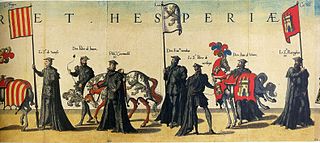 W
WThe first instance of a figure of the lion as symbol of the Kingdom of León is found in minted coins of Alfonso VII, called the Emperor (1126-1157). Until then, the cross had a preponderant position on documents and coins of Leonese monarchs since that reign the cross was gradually displaced by the lion. The Spanish historian and heraldist Martín de Riquer explained that the lion was already used as heraldic emblem in 1148. At the end of the reign of Alfonso VII, the figure of this animal began to appear on royal documents as personal device of the monarch and became pervasive during reigns of Ferdinand II (1157-1188) and Alfonso IX (1188-1230).
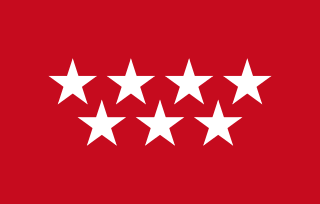 W
WThe flag of the Community of Madrid is crimson red, with seven five-pointed stars in silver, placed four and three in the centre of the field.
 W
WThe flag of the Region of Murcia was defined in Article 4.1 of the Statute of Autonomy of the Region of Murcia, which established the following:The flag of the Region of Murcia is rectangular and consists of four castles with battlements or, in the upper left corner, arranged in rows of two, and seven royal crowns in the lower right corner, arranged in four rows, with a pattern of one, three, two, and one, respectively; against a crimson or carmine red background
 W
WThe flag of Navarre, the flag of the autonomous community of Navarre, was designed in 1910 by Arturo Campión, Julio Altadill, and Hermilio de Oloriz. In 1910, the design was approved by the Provincial Council of Navarre and it was sanctioned by the Organic Law of Reintegration and Improvement of the Regional Government of Navarre of August 10, 1982, which was established in Article 7.2: "The flag of Navarre is red-colored, with a shield in the center."
 W
WThe Pennon of the Conquest is the flag raised by the Moors of Valencia, Spain, on September 28, 1238 on the tower of Alī-Bufāt, later called Torre del Temple, to indicate their surrender to the troops of king James I of Aragon. We know about this episode from the quote entered by the king himself in his Chronicle: "We were in the riverbed, between the gardens and the tower; and when we saw our flag upon the tower, we dismounted from our horse, and heading eastwards we cried from our eyes and kissed the earth for the great mercy God had made to us".
 W
WThe flag of the Second Spanish Republic, known in Spanish as la tricolor, was the official flag of Spain between 1931 and 1939 and the flag of the Spanish Republican government in exile until 1977. Its present-day use in Spain is associated with the modern republican movement, different trade unions and various left-wing political movements.
 W
WThe Senyera is a vexillological symbol based on the coat of arms of the Crown of Aragon, which consists of four red stripes on a yellow field. This coat of arms, often called bars of Aragon, or simply "the four bars", historically represented the King of the Crown of Aragon.
 W
WThe flag of the Valencian Community and of the city of Valencia, known as Reial Senyera, is the traditional Senyera, composed of four red bars on a yellow background, crowned with a blue strip party per pale next to the hoist with 1/4 of the total length. It was adopted on July 1, 1982.
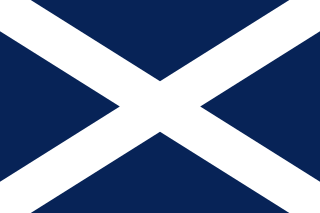 W
WThe flag of Tenerife is a white saltire over a blue field. The arms of the cross are approximately one fifth the width of the flag and the field is navy blue.